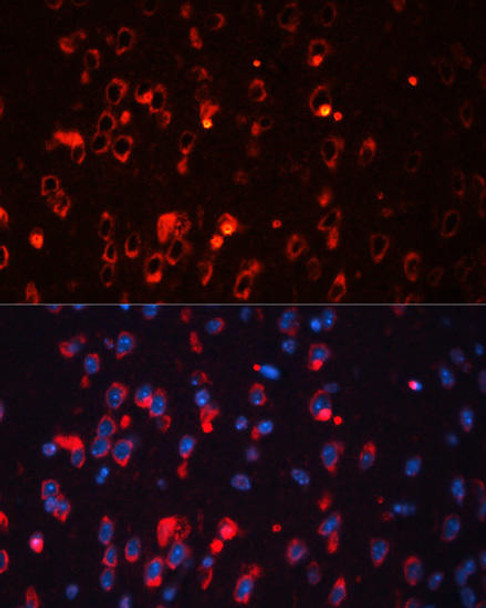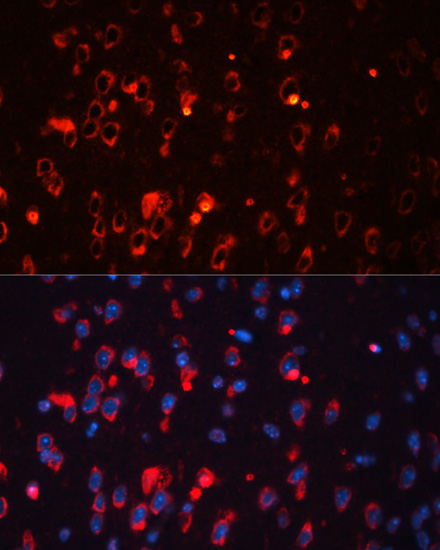Anti-KCNA1 Antibody (CAB16906)
- SKU:
- CAB16906
- Product type:
- Antibody
- Reactivity:
- Mouse
- Reactivity:
- Rat
- Host Species:
- Rabbit
- Isotype:
- IgG
- Antibody Type:
- Polyclonal Antibody
- Research Area:
- Signal Transduction
Description
| 抗体名: | Anti-KCNA1 Antibody |
| 抗体コード: | CAB16906 |
| 抗体サイズ: | 20uL, 50uL, 100uL |
| 申し込み: | IF |
| 反応性: | Mouse, Rat |
| 宿主種: | Rabbit |
| 免疫原: | Recombinant fusion protein containing a sequence corresponding to amino acids 426-495 of human KCNA1 (NP_000208.2). |
| 申し込み: | IF |
| 推奨希釈: | IF 1:50 - 1:200 |
| 反応性: | Mouse, Rat |
| ポジティブサンプル: |
| 免疫原: | Recombinant fusion protein containing a sequence corresponding to amino acids 426-495 of human KCNA1 (NP_000208.2). |
| 精製方法: | Affinity purification |
| ストレージバッファ: | Store at -20°C. Avoid freeze / thaw cycles. Buffer: PBS with 0.02% sodium azide, 50% glycerol, pH7.3. |
| アイソタイプ: | IgG |
| 順序: | QLLH VSSP NLAS DSDL SRRS SSTM SKSE YMEI EEDM NNSI AHYR QVNI RTAN CTTA NQNC VNKS KLLT DV |
| 遺伝子ID: | 3736 |
| Uniprot: | Q09470 |
| セルラーロケーション: | |
| 計算された分子量: | 56kDa |
| 観察された分子量: | Refer to figures |
| 同義語: | KCNA1, AEMK, EA1, HBK1, HUK1, KV1.1, MBK1, MK1, RBK1 |
| バックグラウンド: | This gene encodes a voltage-gated delayed potassium channel that is phylogenetically related to the Drosophila Shaker channel. The encoded protein has six putative transmembrane segments (S1-S6), and the loop between S5 and S6 forms the pore and contains the conserved selectivity filter motif (GYGD). The functional channel is a homotetramer. The N-terminus of the channel is associated with beta subunits that can modify the inactivation properties of the channel as well as affect expression levels. The C-terminus of the channel is complexed to a PDZ domain protein that is responsible for channel targeting. Mutations in this gene have been associated with myokymia with periodic ataxia (AEMK). |
| UniProt Protein Function: | Kv1.1: Mediates the voltage-dependent potassium ion permeability of excitable membranes. Assuming opened or closed conformations in response to the voltage difference across the membrane, the protein forms a potassium-selective channel through which potassium ions may pass in accordance with their electrochemical gradient. Defects in KCNA1 are the cause of episodic ataxia type 1 (EA1); also known as paroxysmal or episodic ataxia with myokymia (EAM) or paroxysmal ataxia with neuromyotonia. EA1 is an autosomal dominant disorder characterized by brief episodes of ataxia and dysarthria. Neurological examination during and between the attacks demonstrates spontaneous, repetitive discharges in the distal musculature (myokymia) that arise from peripheral nerve. Nystagmus is absent. Defects in KCNA1 are the cause of myokymia isolated type 1 (MK1). Myokymia is a condition characterized by spontaneous involuntary contraction of muscle fiber groups that can be observed as vermiform movement of the overlying skin. Electromyography typically shows continuous motor unit activity with spontaneous oligo- and multiplet-discharges of high intraburst frequency (myokymic discharges). Isolated spontaneous muscle twitches occur in many persons and have no grave significance. Belongs to the potassium channel family. A (Shaker) (TC 1.A.1.2) subfamily. Kv1.1/KCNA1 sub-subfamily. |
| UniProt Protein Details: | Protein type:Channel, potassium; Membrane protein, multi-pass; Membrane protein, integral Chromosomal Location of Human Ortholog: 12p13.32 Cellular Component: voltage-gated potassium channel complex; cell surface; endoplasmic reticulum; integral to plasma membrane; cytoplasmic membrane-bound vesicle; dendrite; paranode region of axon; integral to membrane; perikaryon; cytosol; presynaptic membrane; cell soma; apical plasma membrane; plasma membrane; synapse; nerve terminal; cell junction Molecular Function:protein binding; voltage-gated potassium channel activity; potassium channel activity; delayed rectifier potassium channel activity; potassium ion transmembrane transporter activity Biological Process: detection of mechanical stimulus involved in sensory perception of pain; synaptic transmission; regulation of membrane potential; regulation of muscle contraction; neuromuscular process; generation of action potential; protein homooligomerization; potassium ion transport; detection of mechanical stimulus involved in sensory perception of touch Disease: Episodic Ataxia, Type 1 |
| NCBI Summary: | This gene encodes a voltage-gated delayed potassium channel that is phylogenetically related to the Drosophila Shaker channel. The encoded protein has six putative transmembrane segments (S1-S6), and the loop between S5 and S6 forms the pore and contains the conserved selectivity filter motif (GYGD). The functional channel is a homotetramer. The N-terminus of the channel is associated with beta subunits that can modify the inactivation properties of the channel as well as affect expression levels. The C-terminus of the channel is complexed to a PDZ domain protein that is responsible for channel targeting. Mutations in this gene have been associated with myokymia with periodic ataxia (AEMK). [provided by RefSeq, Jul 2008] |
| UniProt Code: | Q09470 |
| NCBI GenInfo Identifier: | 119395748 |
| NCBI Gene ID: | 3736 |
| NCBI Accession: | NP_000208.2 |
| UniProt Secondary Accession: | Q09470,Q3MIQ9, A6NM83, |
| UniProt Related Accession: | Q09470 |
| Molecular Weight: | 56,466 Da |
| NCBI Full Name: | potassium voltage-gated channel subfamily A member 1 |
| NCBI Synonym Full Names: | potassium voltage-gated channel, shaker-related subfamily, member 1 (episodic ataxia with myokymia) |
| NCBI Official Symbol: | KCNA1 |
| NCBI Official Synonym Symbols: | EA1; MK1; AEMK; HBK1; HUK1; MBK1; RBK1; KV1.1 |
| NCBI Protein Information: | potassium voltage-gated channel subfamily A member 1; voltage-gated K(+) channel HuKI; voltage-gated potassium channel HBK1; voltage-gated potassium channel subunit Kv1.1 |
| UniProt Protein Name: | Potassium voltage-gated channel subfamily A member 1 |
| UniProt Synonym Protein Names: | Voltage-gated K(+) channel HuKI; Voltage-gated potassium channel HBK1; Voltage-gated potassium channel subunit Kv1.1 |
| Protein Family: | Potassium voltage-gated channel subfamily |
| UniProt Gene Name: | KCNA1 |
| UniProt Entry Name: | KCNA1_HUMAN |


